3rd GAF Trial About to Go to Jury : Litigation: Telephone records that may refute a key government claim will be important in the latest stock manipulation trial.
- Share via
NEW YORK — The stock market manipulation case against GAF Corp. and its vice chairman is about to go to a jury after a third trial, this time following the late introduction of dramatic new evidence for the defense.
Two earlier trials ended in mistrials, the second in March after a federal jury deliberated 12 days before declaring that it was deadlocked. Jury deliberations in the third trial are due to start Monday.
The new evidence, which defense lawyers said they obtained a few days ago, consists of records of WATS line telephone calls. The records appear to refute a key government claim of a conspiracy to manipulate the price of Union Carbide stock in October, 1986.
GAF, a maker of chemicals and building materials based in Wayne, N.J., and the company’s vice chairman, James T. Sherwin, were named in a federal criminal indictment returned in July, 1988. It accuses Sherwin and the company of hiring the Los Angeles-based brokerage firm Jefferies & Co. to illegally bid up the price of Union Carbide stock to help GAF get a better price for 5 million Carbide shares that it had accumulated and was preparing to sell.
The GAF case is one of several criminal securities fraud cases that grew out of former stock speculator Ivan F. Boesky’s cooperation with prosecutors.
GAF’s lead defense lawyer, Arthur L. Liman, is also the main defense attorney for former Drexel Burnham Lambert Inc. junk bond chief Michael Milken, to be tried next year on racketeering charges.
The new defense evidence in the GAF case relates to testimony by Jefferies & Co.’s head trader, James T. Melton. Melton testified that, under the instructions of Boyd L. Jefferies, the firm’s former chairman and chief executive, he bid up the price of Carbide stock on three consecutive days in October, 1986, and then telephoned Sherwin at the end of the trading day to report on what he had done, including the number of shares purchased and the closing price of the stock.
In both this trial and the previous one, prosecutors said they had no phone records to back up Melton’s claim that he made the calls because they were made on outgoing WATS lines at Jefferies & Co., and WATS customers don’t receive itemized records of their calls. WATS lines are used by businesses that make or receive large numbers of calls, and they aren’t charged for individual calls.
But defense lawyers apparently discovered for the first time within the past couple of weeks that AT&T; maintains its own microfilmed records of all WATS calls, even though such records aren’t provided to customers.
One week ago, the lawyers subpoenaed Jefferies & Co.’s phone records from a fireproof, nuclear bomb-proof AT&T; vault in Mt. Kisco, N.Y. The records were introduced into evidence last Monday. They showed that no WATS calls were made from Jefferies & Co. to GAF’s headquarters or to Sherwin elsewhere on those days.
Defense lawyers and prosecutors refused in interviews this week to discuss the new evidence before a verdict is reached, because the jury hasn’t been sequestered.
It wasn’t clear whether the evidence would have a decisive effect. But in his summation to the jury Thursday, Liman asserted that the new evidence causes the government’s case to “collapse.”
Liman said: “It’s only in the most extraordinary of cases that somebody can find evidence like that that negates the centerpiece of the case.”
The new evidence appears to raise questions about whether prosecutors had been aware of the phone records or, if not, why they never attempted to find out if such records existed.
Both Alan Cohen, head of the U.S. attorney’s securities fraud unit in New York, and Carl H. Loewenson Jr., the lead prosecutor in the case, refused to comment Friday. Defense lawyers also declined to comment on why they hadn’t discovered the existence of the records until a week ago.
In their summations, the prosecutors asserted that the stock manipulation charges were adequately supported by other witnesses in the case.
As in the previous two trials, the lead witness this time was Boyd Jefferies himself, who cooperated with the government after pleading guilty to two felony counts of securities law violations.
As part of his agreement with prosecutors, Jefferies & Co. and its employees are exempt from prosecution providing that they, too, cooperate with the government. Jefferies testified that Sherwin had asked him to manipulate the price of Carbide’s stock, and Jefferies said he had given the assignment to Melton.
U.S. District Judge Mary Johnson Lowe declared a mistrial in the first trial before testimony ended because she found that the government had inadvertently withheld an expert witness’ report from the defense.
One new witness who appeared for the first time in the third trial was actress Liv Ullmann, who testified Tuesday as a character witness for Sherwin. The GAF vice chairman and Ullmann knew each other from work they had done during the past decade for the International Rescue Committee, a nonprofit organization that helps relocate refugees.
More to Read
Inside the business of entertainment
The Wide Shot brings you news, analysis and insights on everything from streaming wars to production — and what it all means for the future.
You may occasionally receive promotional content from the Los Angeles Times.









